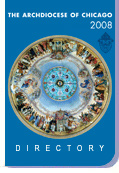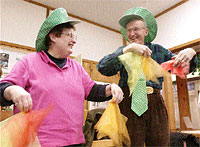 |
 |
|||||
 |
 |
 |
 |
 |
|||
 Eileen and Marty Hynes laugh while learning to juggle scarves during an exercise at their CHEER meeting at Chicago Ridge Mall on March 10. Catholic New World photos/Karen Callaway |
Spreading CHEER
Michelle Martin Malloy leaned back in his chair, stretched his long legs in front of him, and started cracking jokes. Wearing an oversized green plastic tam o’shanter, and fluffing the red and orange scarves he held in front of his face, Malloy accepted the good-natured teasing of his friends about his unexpected skill in juggling. “I spent six years in clown college,” he deadpanned. But Malloy, an Evergreen Park engineer, never had any formal juggling training, and neither did any of the other 20 or so people who gather the second Wednesday of every month at Little Company of Mary Hospital’s Health Education center in Chicago Ridge Mall. “They don’t mind if I get goofy,” said Malloy, who has always known the value of humor. “There are just such nice people here,” added Eileen Hynes of Chicago. “You can tell how much people like it, because it ends at 8 p.m. and they have to kick us all out at quarter to nine.” What the patients mostly have in common is a history of cancer or some other chronic disease, and a desire to use humor to help them cope. Malloy has leukemia and diabetes; Hynes has a history of uterine cancer and her husband, Marty, had a melanoma; Jean O’Hara, who has been with the group since it started seven years ago, was already a cancer survivor then. “I started coming because I’d been going to the cancer survivor support groups, and everyone would talk about being sick,” O’Hara said. “I just thought I was ready to move on.” Moving on—and just plain moving your body—fit well into the advice offered by Joan Murphy, the hospital’s director of community health services, and Anne Bartalotta, manager of health education services. The two—both nurses—work together on the CHEER program. “Remember, when you’ve had a rough day, or you’re just in a bad mood, put on some jazzy music and get your scarves and do some juggling,” Bartalotta said. “Do something to get yourself out of that mood.” The two trace their interest in using humor to enhance health to Norman Cousins, who famously checked himself into a hotel with days’ worth of comedy movies to help cope with the pain of ankylosing spondylitis. He wrote about his experience in “Anatomy of an Illness.” “People ask us what’s so funny about having a chronic disease,” said Murphy, whose 1993 doctoral dissertation was a guide to help health care centers put humor to work helping patients. “It’s not that the illness is funny. But the power of humor is that it puts chemicals into the body that will help ease the pain and stress and anxiety.” So like pediatric nurses who come bearing toys to distract and comfort little ones, Bartalotta and Murphy make their entrances with props like singing stuffed animals and jars full of smiles. They coordinate an in-patient program at the hospital in which volunteers take “the humor cart”—a red Craftsman tool chest on wheels, with a TV/VCR unit on top—to visit patients. The cart comes stocked with toys, books, games, audio and videotapes. There are Mickey Mouse cartoons, John Candy movies, columns by Erma Bombeck and Mike Royko. Anything to get a smile. When the patients go home, the volunteers make sure to invite them to Spreading CHEER. (“CHEER” stand for Choices, Humor, Enhancement, Education and Renewal.) Each monthly meeting includes a presentation on some aspect of humor, often with a guest speaker, along with some activities to get participants involved. It’s not a support group, but members get to know one another and often linger after the meetings. “It’s about laughter, fun, community,” Bartalotta said. “It’s about bringing new energy, new life to people.” The evening that ended with juggling activity started with a video or short clips of people laughing. Before showing it, Murphy said that research shows young children laugh—really laugh, from their bellies—30 to 40 times a day. The average adult laughs that way maybe once or twice a week, she said. By the end of the video, everyone in the room was laughing. The evening also included some questions to reflect on, asking participants to remember favorite funny movies, TV shows (“I Love Lucy” seemed to touch a chord) and moments from their own lives. Murphy suggested they begin noting down things they find funny, a stockpile of day brighteners. She also offered some stress-busting phrases ranging from “This too shall pass” to “I’ve got one nerve left. How’d you find it?” “That’s one of the things humor does,” she said. “It gives you perspective.” And it’s not all about funny lines. One technique Murphy and Bartalotta suggest is for people to look back at their childhood, and think about what they liked to do when they were, say, 5 years old, and think about the people who helped them do it. “We recognize that play therapy and humor therapy are not just about jokes and wit,” Murphy said. “It is about what brings you happiness, and the people who have helped you along the way. … The gift that is in each and every one of us is serenity and peace. That’s the outcome of laughter. The outcome is joy. Humor isn’t jokes and wit. It’s in life experience.” |
||
|
|
|||